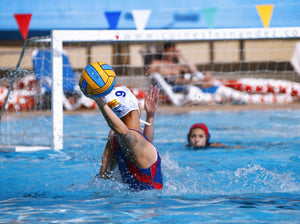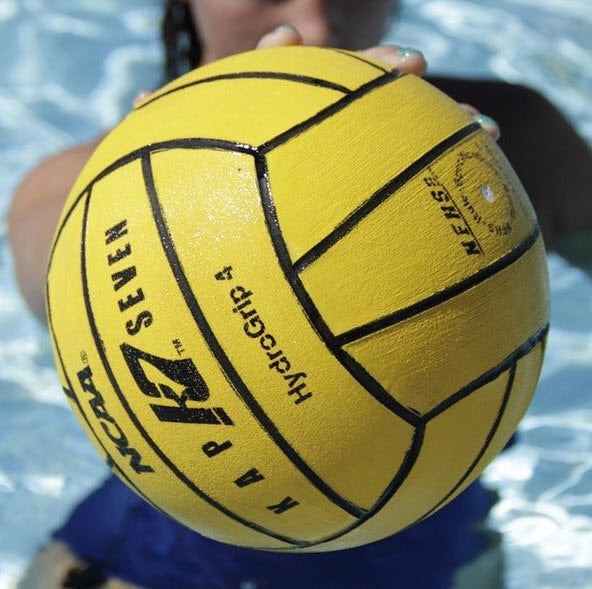Advanced Water Polo Ball Handling Skills
 After you have mastered the basics of water polo, one way to take your game to the next level is to work on advanced ball handling drills. These drills force you to handle the ball in unfamiliar and challenging ways, all designed to improve your control over the ball. The new agility and endurance you will gain from these drills will give you a true edge in the water. This guide includes several drills that teach you how to control and move the water polo ball in new ways.
After you have mastered the basics of water polo, one way to take your game to the next level is to work on advanced ball handling drills. These drills force you to handle the ball in unfamiliar and challenging ways, all designed to improve your control over the ball. The new agility and endurance you will gain from these drills will give you a true edge in the water. This guide includes several drills that teach you how to control and move the water polo ball in new ways.
Foot-to-hand Kicks
The foot-to-hand kicking drill is one of the few drills that incorporates footwork into a water polo exercise. Using your foot to move the ball is actually allowed in water polo games, but because your feet are usually underwater eggbeatering for other exercises, it is hard to set aside practice time for just foot skill development.
The move in this drill can actually come in quite handy in a game situation. To practice the foot-to-hand drill, lay out on the surface of the water. Drop the ball on the water above your foot. If you are kicking the ball from your right foot to your right hand, scull with your left hand and get your right hand ready to pop up out of the water. Next, bring your right foot up, close to the surface of the water and with a quick pop of the ankle, kick the ball into your right hand. Practice using both hands and both feet to improve your dexterity. You won't get it on the first try, but after enough practice you will have an intuitive feel for how to kick the ball into your hand.
Head Juggling
Toss the water polo ball straight up in the air. Position yourself under it and use your forehead to bounce the ball back up into the air. Keep the ball up in the air and do as many bounces as you can. Keep your legs eggbeatering strongly under you and keep your hands sculling under water for balance and support.
For a more challenging drill, combine head and leg juggling while your hands scull. This drill works your arms (sculling), your legs (treading and/or juggling), your core, and your response time. Because it combines cardio with agility, this is a true multi-tasking drill.
Rather than doing a conditioning set that focuses on one thing (legs, sculling, swimming, etc), pick a drill that instead incorporates multiple muscle groups, and different water polo skills. Combining conditioning with agility work maximizes the returns you’ll get from your time in the water.
Dry Ball Dribbling
Slower and more challenging than regular dribbling, dry ball dribbling is a new take on swimming with the ball that requires more strength, balance, and agility. There are two versions of this drill.
One version of dry ball dribbling incorporates heads-up freestyle and ball handling. Start by holding the water polo ball in front of you at arms' length, slightly above the water. With your other arm, start a heads-up freestyle stroke . As soon as your hand not holding the ball is next to your other hand, quickly transfer the ball. Now, start your underwater pull with the arm that was holding the ball. Continue the stroke to bring your arm around and over the water and transfer the ball to this hand again. Continue taking strokes and transferring the ball from one hand to the other until you have reached the other end of the pool. The ball should stay out in front of you, a few inches above the surface at all times. Keep your head up and your kicks strong — your legs will be the main reason you stay afloat, as your arms work to keep the ball above the water.
The other version of this drill incorporates heads-up backstroke and ball handling. The ball can be held at your hips, or extended behind your head for a more challenging version. The pattern of stroke-transfer-stroke is the same. Backstroke dry ball dribbling is easier than the freestyle version since you can float on your back and breathe with less effort.
Practice dry ball dribbling with breaststroke, scissor, and eggbeater kicks. This will slow the drill down, but that's fine: The goal here is not speed. Rather, concentrate on controlling the ball and maintaining form. You will see the benefits in your improved dexterity and power.
More than Fooling Around
Although these drills don't always have an obvious application in a game of water polo, the skills that they require are certainly those of more advanced water polo players. Working on these drills will improve your dexterity, power, and general ball handling skills. Incorporating these types of exercises into regular water polo practices force you to use new muscles and control the ball in different ways. Mixing it up isn't just good for your overall water polo skills, it's fun too!



